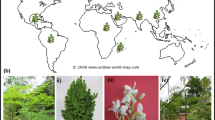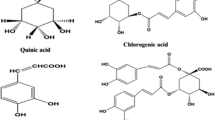Abstract
This study aimed to investigate the preventive role of Elateriospermum tapos seed extract against obese Sprague Dawley rats through assessment of bodyweight, caloric intake, organs weight, biological assays and histopathology. Thirty-six male Sprague Dawley rats were assigned into six groups of normal control (G1) group fed with standard chow diet, negative control (G2), positive control (G3) and treatment groups (G4, G5 and G6) were on high-fat and cafeteria diet for 9 weeks. G3 group was given 10 mg kg−1 of Orlistat while treatment groups were supplemented with E. tapos seed extract of 5 mg kg−1, 25 mg kg−1 and 125 mg kg−1 orally daily for another 10 weeks. Bodyweight and food intake were monitored weekly. At the end, liver, retroperitoneal white adipose tissue (rpWAT) and blood were collected for analysis of total cholesterol (TC), triglycerides (TG), low-density (LDL-C) and high density lipoprotein (HDL-C). The E. tapos seed treated groups showed significant (p < 0.05) reduction in bodyweight, caloric intake, liver and rpWAT weight as compared to the G2 group. G6 group showed tremendous improvement of liver histopathology and biological assay. There was a significant decrease (p < 0.05) of TC, TG, and LDL-C level and significant increase (p < 0.05) of HDL-C in the E. tapos seed treated group as compared to G2 group. Based on the findings, E. tapos seed extract exhibited a great potential as an anti-obesity. The extract promoted the fat oxidation by removing the uptake and storage of fat by the adipose cells and also decrease the fatty acid synthesis.


Similar content being viewed by others
References
Alagawadi KR, Kumar S, Rao MR (2011) Effect of Argyreia speciosa root extract on cafeteria diet-induced obesity in rats. Indian J Pharmacol 43:163–167
Albert K (1999) Liquid chromatography—nuclear magnetic resonance spectroscopy. J Chromatogr 856:199–211
Ali KM, Wonnerth A, Huber K, Wojta J (2012) Cardiovascular disease risk reduction by raising HDL cholesterol—current therapies and future opportunities. Br J Pharmacol 167:1177–1194
Alwan A (2011) Global status report on noncommunicable diseases 2010. World Health Organization
Arçari DP, Bartchewsky W, Dos Santos TW, Oliveira KA, Funck A, Pedrazzoli J, Ribeiro ML (2009) Antiobesity effects of Yerba mat extract (ilex paraguariensis) in high-fat diet-induced obese mice. Obesity 17:2127–2133
Awang M, Furukawa A, Kawaguchi H, Osada N, Takeda H (2003) Estimation of crown characters and leaf biomass from leaf litter in a Malaysian canopy species, Elateriospermum tapos (Euphorbiaceae). For Ecol Manag 177:379–386
Batterham A, Ells LJ, Heslehurst N, Simpson H, Summerbell CD, Wilkinson J (2007) Trends in maternal obesity incidence rates, demographic predictors, and health inequalities in 36,821 women over a 15-year period. BJOG Int J Obstet Gynaecol 114:187–194
Castellarin SD, Di Gaspero G (2007) Transcriptional control of anthocyanin biosynthetic genes in extreme phenotypes for berry pigmentation of naturally occurring grapevines. BMC Plant Biol 7:46
Chen C-S, He J, Kelly T, Reynolds K, Yang W (2008) Global burden of obesity in 2005 and projections to 2030. Int J Obes 32:1431–1437
Cheurfa M, Allem R (2015) Study of hypocholesterolemic activity of Algerian Pistacia lentiscus leaves extracts in vivo. Rev Bras Farmacogn 25:142–144
Desai MY, Dalal D, Santos RD, Carvalho JA, Nasir K, Blumenthal RS (2006) Association of body mass index, metabolic syndrome, and leukocyte count. Am J Cardiol 97:835–838
Dunn-Meynell AA, Levin BE (2002) Defense of body weight depends on dietary composition and palatability in rats with diet-induced obesity. Am J Physiol Regul Integr Comp Physiol 282:R46–R54
Gómez-Hernández A, Beneit N, Díaz-Castroverde S, Escribano Ó (2016) Differential role of adipose tissues in obesity and related metabolic and vascular complications. Int J Endocrinol. https://doi.org/10.1155/2016/1216783
Hughes LAE, Arts ICW, Ambergen T, Brants HAM, Dagnelie PC, Goldbohm RA, van den Brandt PA, Weijenberg MP (2008) Higher dietary flavone, flavonol, and catechin intakes are associated with less of an increase in BMI over time in women: a longitudinal analysis from the Netherlands Cohort Study. Am J Clin Nutr 88:1341–1352
Husin N, Tan NAH, Muhammad II, Nawi NM (2013) Physicochemical and biochemical characteristics of the underutilized Elateriospermum tapos. J Teknol 64:57–61
Kawser Hossain M, Abdal Dayem A, Han J, Yin Y, Kim K, Kumar Saha S, Yang GM, Choi HY, Cho S-G (2016) Molecular mechanisms of the anti-obesity and anti-diabetic properties of flavonoids. Int J Mol Sci 17:569
Khairunnuur FA, Zulkhairi A, Hairuszah I, Azrina A, Nursakinah I, Fazali F, Kamilah KAK (2010) Hypolipemic and weight reducing properties from Tamarindus indica L. pulp extract in diet-induced obese rats. Int J Pharmacol 6:216–223
Khaserao S, Somani R (2017) Evaluation of anti-obesity activity of solasodine in high fat diet-induced obesity in rat. Int J Pharm Pharm Sci 9:23–29
Li Z, Xu J, Zheng P, Xing L, Shen H, Yang L, Zhang L, Ji G (2015) Hawthorn leaf flavonoids alleviate nonalcoholic fatty liver disease by enhancing the adiponectin/AMPK pathway. Int J Clin Exp Med 8:17295–17307
Mathieu P, Lemieux I, Després JP (2010) Obesity, inflammation, and cardiovascular risk. Clin Pharm Ther 87:407–416
Running W (1993) Computer Software Reviews. Chapman and Hall dictionay of natural products on CD-ROM. J Chem Int Comput Sci 33:934–935
Ruager-Martin R, Hyde MJ, Modi N (2010) Maternal obesity and infant outcomes. Early Hum Dev 6:715–722
Sikaris KA (2004) The clinical biochemistry of obesity. Clin Biochem Rev Aust Assoc Clin Biochem 25:165–181
Weggemans RM, Trautwein EA (2003) Relation between soy-associated isoflavones and LDL and HDL cholesterol concentrations in humans: a meta-analysis. Eur J Clin Nutr 57:940–946
World Health Organisation, WHO (2016) Factsheet: obesity and overweight. WHO, Geneva
Wu Y (2006) Overweight and obesity in China. BMJ 333:362–363
Youdas JW, Hollman JH, Krause DA (2006) The effects of gender, age, and body mass index on standing lumbar curvature in persons without current low back pain. Physiother Theory Pract 22:229–237
Yun JW (2010) Possible anti-obesity therapeutics from nature—a review. Phytochemistry 71:1625–1641
Acknowledgements
The authors would like to thanks Ministry of Higher Education (MoHE) (FRGS/1/2016/SKK08/UPM/02/14), and Universiti Putra Malaysia (GP-IPS/2017/9516300) for funding this project.
Author information
Authors and Affiliations
Corresponding author
Ethics declarations
Ethical statement
All procedures involving animal were conducted under the approval of the Animal Care and Ethics Committee, UPM (IACUC R037/2016).
Conflict of interest
Kokila Vani Perumal has no conflict of interest. Nor Liyana Ja’afar has no conflict of interest. Santhra Segaran Balan has no conflict of interest. Azrina Zainal Abidin has no conflict of interest. Daryl J. Arapoc has no conflict of interest. Nurul Husna Shafie has no conflict of interest. Hasnah Bahari has no conflict of interest.
Additional information
Publisher's Note
Springer Nature remains neutral with regard to jurisdictional claims in published maps and institutional affiliations.
Rights and permissions
About this article
Cite this article
Perumal, K.V., Ja’afar, N.L., Balan, S.S. et al. Preventive effect of Elateriospermum tapos seed extract against obese Sprague Dawley rats. ADV TRADIT MED (ADTM) 20, 107–113 (2020). https://doi.org/10.1007/s13596-019-00394-w
Received:
Accepted:
Published:
Issue Date:
DOI: https://doi.org/10.1007/s13596-019-00394-w




